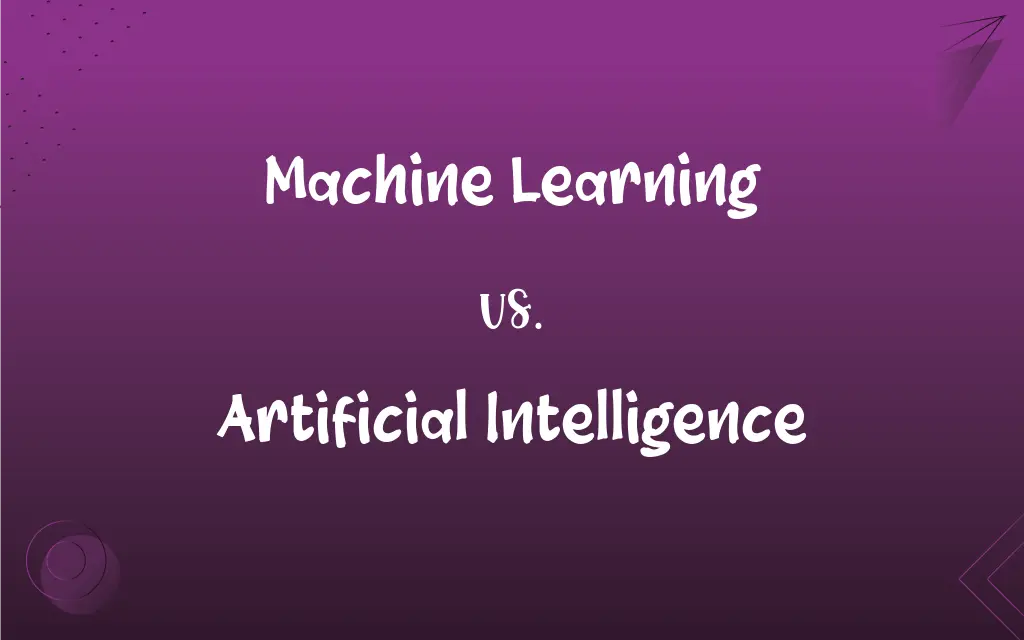Machine Learning vs. Artificial Intelligence: What's the Difference?
Edited by Harlon Moss || By Janet White || Updated on November 15, 2023
Machine Learning is a subset of Artificial Intelligence focused on data-driven algorithms. Artificial Intelligence encompasses a broader field of making machines mimic human intelligence.

Key Differences
Machine Learning revolves around the concept of allowing machines to learn from data. It emphasizes algorithms that can recognize patterns, adjust to data inputs, and improve over time. Artificial Intelligence, on the other hand, is the broader discipline of creating machines that can perform tasks requiring human-like intelligence.
Artificial Intelligence encompasses many subfields, not just Machine Learning. These include robotics, natural language processing, and expert systems. Machine Learning, however, is primarily concerned with data and algorithms that enable models to perform specific tasks without explicit programming.
Machine Learning usually requires a substantial amount of data to train its models. The goal is for the machine to generalize from this data to make predictions or decisions without human intervention. In contrast, Artificial Intelligence might use a combination of rule-based logic, optimization techniques, and other methods to simulate intelligent behavior.
Artificial Intelligence aims to create systems that can carry out tasks that, when done by humans, involve intelligence. This could range from playing chess to visual recognition. Machine Learning is a key technique AI might utilize, but it's not the only one. It's like saying every square (Machine Learning) is a rectangle (Artificial Intelligence), but not every rectangle is a square.
Comparison Chart
Definition
Subset focusing on algorithms that learn from data.
Broad discipline of mimicking human intelligence in machines.
ADVERTISEMENT
Scope
Limited to data-driven tasks.
Includes robotics, NLP, expert systems, etc.
Learning
Learns from vast data sets.
Can use rules, optimization, or data-driven methods.
Goal
Improve performance on specific tasks with data input.
Simulate human-like intelligence in various tasks.
Dependency
Depends on data for accuracy.
Can work with or without data.
Machine Learning and Artificial Intelligence Definitions
Machine Learning
Self-improving algorithms.
The recommendation engine used Machine Learning to fine-tune suggestions based on user feedback.
ADVERTISEMENT
Artificial Intelligence
Broad field of machine cognition.
Artificial Intelligence research spans from playing games to medical diagnosis.
Machine Learning
Automatic pattern recognition in data.
With Machine Learning, the program recognized faces in photographs with increasing accuracy.
Artificial Intelligence
Systems performing tasks requiring human-like reasoning.
Through Artificial Intelligence, the chatbot could engage in natural conversations.
Machine Learning
Algorithms that improve from experience.
Through Machine Learning, the software predicted user preferences more accurately over time.
Artificial Intelligence
Machines mimicking human intelligence.
Artificial Intelligence enabled the robot to navigate complex environments.
Machine Learning
Subset of AI focused on data analysis.
Machine Learning techniques processed vast amounts of text to detect spam emails.
Artificial Intelligence
Automation of intelligent behavior.
With the help of Artificial Intelligence, the car could drive autonomously in traffic.
Machine Learning
Data-driven approach to model training.
Using Machine Learning, the system identified patterns in sales data to forecast future demand.
Artificial Intelligence
Machines making decisions and predictions.
Artificial Intelligence tools assisted doctors in identifying potential diseases in X-rays.
FAQs
What's the main difference between Machine Learning and Artificial Intelligence?
Machine Learning is a subset of Artificial Intelligence focusing on data-driven algorithms.
Are all AI systems self-learning?
No, only those using Machine Learning or similar techniques are self-learning.
Can an AI system work without Machine Learning?
Yes, AI can use rule-based or other non-data-driven methods.
Why is data crucial for Machine Learning?
Machine Learning algorithms rely on data to learn, improve, and make predictions.
How does Machine Learning differ from traditional programming?
Traditional programming follows explicit instructions, while Machine Learning learns from data patterns.
Why is Artificial Intelligence important in today's world?
AI can automate complex tasks, enhance user experiences, and solve previously intractable problems.
How does Artificial Intelligence impact jobs?
AI can automate certain tasks but also creates new opportunities and requires human collaboration.
What's the goal of Artificial Intelligence?
The goal is to create systems that can perform tasks requiring human-like intelligence.
Can Machine Learning operate without Artificial Intelligence?
Machine Learning is inherently a part of AI, so it's a form of AI in action.
Is Machine Learning necessary for Artificial Intelligence?
No, AI can use various techniques, but Machine Learning is a prevalent method.
How do Machine Learning models improve over time?
They refine their predictions by continuously learning from new data and feedback.
Are neural networks part of Machine Learning or Artificial Intelligence?
Neural networks are a subset of Machine Learning, which is a subset of Artificial Intelligence.
Can Artificial Intelligence surpass human intelligence?
It's a topic of debate, but currently, AI excels only in specific tasks compared to general human intelligence.
Can Machine Learning algorithms exhibit bias?
Yes, if trained on biased data, Machine Learning algorithms can perpetuate or amplify biases.
Is Artificial Intelligence a recent concept?
No, AI concepts date back to ancient history, but modern AI research began in the mid-20th century.
Can Machine Learning be used in healthcare?
Yes, Machine Learning can help in diagnostics, treatment suggestions, and patient management.
Is Artificial Intelligence safe?
AI's safety depends on its design, implementation, and use. Proper safeguards and ethical considerations are essential.
What are the prerequisites for implementing Machine Learning?
A substantial amount of relevant data, computational power, and expertise are typically needed.
How does Machine Learning handle unstructured data?
Advanced techniques like deep learning can process unstructured data like images and text.
How "intelligent" are current Artificial Intelligence systems?
Most AI systems are specialized in specific tasks and lack general human-like intelligence.
About Author
Written by
Janet WhiteJanet White has been an esteemed writer and blogger for Difference Wiki. Holding a Master's degree in Science and Medical Journalism from the prestigious Boston University, she has consistently demonstrated her expertise and passion for her field. When she's not immersed in her work, Janet relishes her time exercising, delving into a good book, and cherishing moments with friends and family.
Edited by
Harlon MossHarlon is a seasoned quality moderator and accomplished content writer for Difference Wiki. An alumnus of the prestigious University of California, he earned his degree in Computer Science. Leveraging his academic background, Harlon brings a meticulous and informed perspective to his work, ensuring content accuracy and excellence.






































































